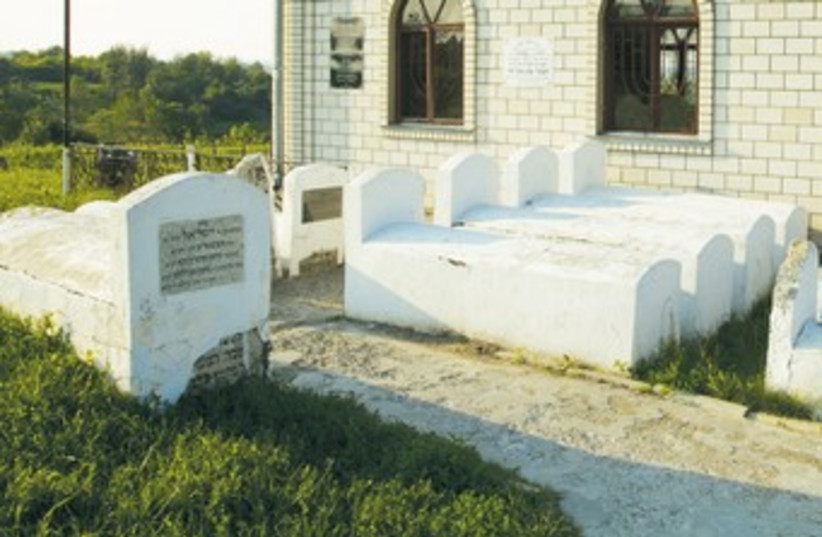Rabbi Moshe Hayim Efrayim of Sudylkow was the son of Yehiel and Odel – the daughter of the famous Rabbi Yisrael Baal Shem Tov (Besht, ca. 1700-1760). Efrayim – as his grandfather called him – grew up in Mezhibuzh in the Besht’s circle. In a letter penned in the 1750s, the Besht boasted to his brother-in-law of the learning prowess of his young grandson.
We do not know exactly when Efrayim was born. Scholars offer two possible birth years: 1742 or 1748. Dating the birth of Efrayim is significant when considering what young Efrayim may have heard and absorbed from his illustrious grandfather. At the very least he was 12 when the Besht passed away.
Rabbi Efrayim served in a rabbinic function in Sudylkow – a small town, 100 km. north of Mezhibuzh. Sometime around 1788, he returned Mezhibuzh. He passed away in 1800 and was buried close to his grandfather.
Ten years later, in 1810, Rabbi Efrayim’s hassidic teachings were published under the title Degel Mahane Efrayim. This volume would ensure his legacy, and he is widely referred to by an abbreviated title of the work: “The Degel”; that is, the flag.
Degel Mahane Efrayim is paramount to understanding the messages of the Besht. When learning the Degel’s accounts of the Besht and his teachings, there are three points of contrast. Studying the Degel with these foils allows us to begin to sketch a portrait of the Besht’s intellectual and spiritual legacy.

The first foil is the writings of one of the Besht’s senior disciples: Rabbi Ya’akov Yosef Hakohen of Polonne (d. 1779). His volumes – Toledot Ya’akov Yosef (published in 1780), Ben Porat Yosef (1781), Tzofnat Paneah (1782), as well the later Ketonet Passim (1866) – provide the earliest collection of Besht Torah. Indeed, the Degel regularly cites from the first three volumes.
The second foil appears in the writings of the school of a key Besht disciple: Rabbi Dov Ber the Maggid of Mezritch (d. 1772). The Degel occasionally cites the Maggid’s Torah. While the Maggid did not bequeath hassidic writings, his teachings reach us through his circle of students, who were avid writers.
The third foil comes from the family: The Degel’s younger brother, Rabbi Baruch of Mezhibuzh (ca. 1753-1811), and their nephew Rabbi Nahman of Breslov (1772-1810).
WHAT SOURCE might serve as the starting point in the quest to reconstruct the Besht’s legacy? The student Rabbi Ya’akov Yosef, the school of the Maggid, and the grandsons Rabbi Efrayim and Rabbi Baruch, and great-grandson Rabbi Nahman – were all bearers of the Besht’s legacy. However, it could be argued that the Degel is the best source for understanding the Besht and contemplating his original teachings.
The Toledot was an accomplished scholar who joined the ranks of the Besht. His works, therefore, include his own ideas, as well as those of his esteemed teacher. Works penned by the disciples of the Maggid are removed by a generation or more from the Besht, and they largely reflect the Maggid’s understanding of the Besht’s messages. Rabbi Nahman of Breslov was born 12 years after his great-grandfather passed away, and never had the opportunity to personally interact with his venerated ancestor.
Rabbi Baruch of Mezhibuzh was a young boy of seven when the Besht died. He may have remembered some of his grandfather’s teachings. He did not prepare a collection of teachings. His work, Butzina Denehora, was first published in Lemberg in 1879 – over 50 years after his demise and over a century after the Besht passed away.
Moreover, there were rabbinic authorities who questioned the authenticity of the collection, voicing harsh words against the publisher and accusing him of deception and forgery for the sake of financial gain.
WHILE THE Degel might be the most reliable source, the foils serve two important functions. First, a teaching that appears in the Degel and in other works suggests the hassidic authenticity of the idea. This does not mean that the particular idea – perforce – is a hassidic idea since it might be a broader Jewish, religious, or spiritual notion. Indeed, not every idea that appears in a work penned by a hassidic master is necessarily “hassidic” in form or content.
Considering this caveat, we might say that teachings that appear in the Degel and in other early hassidic volumes might be hassidic ideas, or at the very least ideas adopted by hassidism.
The second way that foils work is that teachings can be read as though they were in conversation. Degel Mahane Efraim does not have a polemic style. To be sure, the Degel voices critique, though he does not clearly identify to whom he is referring.
Such passages reveal deliberations over the Besht’s messages and legacy. Thus, for example, in one passage the Degel slams the decentralized nature of hassidic leadership, stating that each master seeks to conquer a town as his own. Without mentioning names, the Degel appears to be critiquing the leadership structure that emerged from around the table of the Maggid of Mezritch.
In other cases, we hear different strands of similar ideas. Thus, the Degel acknowledges clapping hands as a spiritual practice, though he criticizes fake clappers. The Degel’s nephew, Rabbi Nahman, is famous for promoting the mystical efficacy of clapping, and the act was part of his own religious practice. The two sources suggest that clapping may have been part of the Besht’s spiritual world, even though it may not be clear just how central the practice was.
Thus – in addition to being an early collection of hassidic teachings – the Degel is an important touchstone for distilling the innovative ideas of the Besht and the authentic legacy of hassidism in its formative years. This then provides a baseline for considering how hassidism has evolved over the ages. ■
The writer is on the faculty of the Pardes Institute of Jewish Studies and is a rabbi in Tzur Hadassah.
